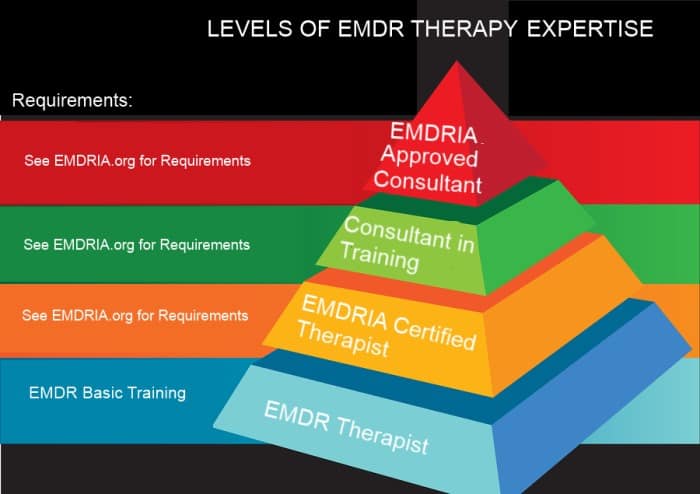EMDR (Eye Movement Desensitization and Reprocessing) is a reliable therapy treatment that can make a huge difference in your clients’ lives while also helping you grow as a therapist.
If you are a mental health practitioner wishing to advance your skills, EMDR training can help you better serve your clients. EMDR training can even reduce the amount of time required for therapy. In other words, it can assist your clients more quickly and efficiently.
Contents
What is EMDR?
EMDR is a type of psychotherapy that helps people recover from the physical and emotional suffering caused by traumatic events in their lives. Studies have shown that by employing EMDR, patients can reap the advantages of psychotherapy that formerly took years to achieve.
EMDR treatment demonstrates that the mind can heal from psychological trauma in the same way that the body heals from physical damage.
How Does EMDR Therapy Help?
EMDR has been shown in studies to be an effective approach to decreasing or eliminating PTSD symptoms altogether. The treatment is typically used in several sessions to treat PTSD.
By initially stimulating the memories, EMDR helps individuals get rid of these sensations and ideas. This transfers the memory to their working memory or short-term memory.
An EMDR therapist directs the client’s eye movements as they relive and talk about traumatic experiences in EMDR. They do this by asking their client to follow their fingers back and forth with their eyes as they focus on this incident.
Working memory processes a large amount of data at once this way. Individuals can talk about their experiences while their focus is distracted by their eye movements in this sort of treatment. Making it easier for the client to start thinking differently about the traumatic event.
Due to this distraction, the psychological impact of these triggering situations reduces as more EMDR sessions are completed. This implies the person will ultimately be able to go about their daily activities without these terrible memories interfering.
Because of the increased emphasis, the beginning of treatment can be quite upsetting for those who are dealing with traumatic situations. While the therapy will most likely be helpful in the long term, the process of treatment may be emotionally draining.
EMDR Training Options
Getting your EMDR training is another step in the process of assisting individuals suffering from PTSD. As licensed therapists, one of the most crucial aspects is to assist people who have experienced various types of trauma.
Finding an excellent EMDR training resource is just as important as having the skills to help people in difficult situations.
EMDRIA
The EMDR International Association also known as EMDRIA, provides the global standards for EMDR practice. They feature a range of approved EMDR training sources on their website.
An EMDRIA Approved EMDR Training gives practitioners the information and abilities to use EMDR therapy, as well as a thorough grasp of case conceptualization and treatment planning and the capacity to incorporate EMDR therapy into their therapeutic practice.
It is probably in your best interest to enroll in a course that has been authorized by the EMDRIA.
After that, you will get an EMDR International Association Therapist Certificate from the EMDRIA.
It is worth noting, though, that you do not need EMDRIA permission to get certified in EMDR. Various organizations provide certification and rules of their own. EMDRIA keeps you informed about all EMDR-related news.
EMDR Institute
Licensed mental health practitioners who treat adults and children in a professional environment should do the EMDR Therapy Basic Training.
The Adaptive Information Processing concept guides EMDR treatment, which treats unprocessed memories that appear to be the root of a wide spectrum of problems. You will have to study the textbook Eye Movement Desensitization and Reprocessing by Francine Shapiro.
What Do You Need for EMDR Training?
For studying and training in EMDR, you mostly need the literature, which is typically the guide published by Francine Shapiro. While EMDR doesn’t necessarily require tools, having tools for bilateral stimulation can make your training even easier.
You can go for an EMDR kit that includes products for all types of bilateral stimulation. Alternatively, you can use just one tool.
EMDR Kit Products
EMDR Kit currently provides two product lines, one operated by a controller and the other through a mobile phone app. They provide packages that include all of the modalities you might want to utilize such as auditory, tactile, and visual.
However, you can also buy individual modalities if you do not want to work with all of them. Both the EMDR Kit Classic and the Wireless EMDR Kit appear to have a high number of lights on them, making the movement of the light dot incredibly smooth.
Both sets allow you to alter settings so there is no need to interrupt your session if you need to make a change. The number of Bilateral Stimulation (BLS) sets or times may be seen on the controller’s or app’s display.
Price
The cost of the Classic EMDR Kit is €384.30. On the other hand, the EMDR Kit Wireless complete set costs €433.88. The pieces can also be purchased separately.
It is a significant investment, but with the EMDR Kit, you’ll receive the most value for your money. After having a taste of working with tools, you’ll never want to work without them again!
Verdict
EMDR therapy helps people recover from traumatic situations by removing pain and unsettling memories. It also frees individuals from difficult feelings and ideas, as well as uncomfortable physical sensations and imprisoned emotions.
In the EMDR community, we are on a quest to master EMDR therapy, we learn together, save time, and increase efficiency. EMDR Kit provides equipment that is both attractive and functional. The EMDR Kit comes with several choices that you may use to customize it for every client.






